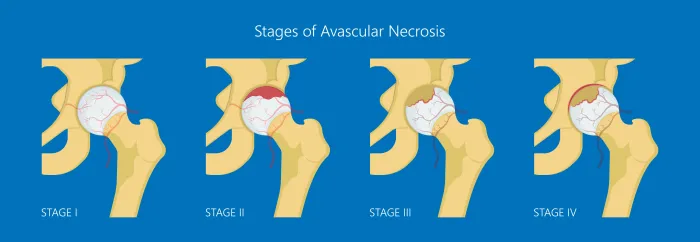Avascular Necrosis
(Osteonecrosis)
Avascular necrosis, or osteonecrosis, refers to the death of a person's bone tissue due to a lack of blood supply. This disease can affect anyone, but it most commonly affects those who are between 30 to 50 years of age.
Your orthopedic surgeon can help you find the best long-term solution for pain you may be experiencing as a consequence of avascular necrosis.
What You Need To Know About Avascular Necrosis

What Is Avascular Necrosis (Osteonecrosis)?
Avascular necrosis — sometimes called AVN, osteonecrosis, or bone infarction — is a disorder where the blood flow to your bone tissue is completely blocked off. This inhibits your body's ability to regenerate new bone tissue, causing the bone to fracture and collapse slowly over the course of months or years.
Types of Osteonecrosis
There are two types of avascular necrosis: traumatic and nontraumatic.
Traumatic osteonecrosis occurs after you sustain a significant injury, like breaking a bone or dislocating a joint. Nontraumatic osteonecrosis occurs as a result of a separate medical condition that affects your blood flow or some other behavioral cause, as long as it's not explained by an injury.
Sometimes the cause isn't clear. In fact, around 20% of osteonecrosis cases occur with no obvious cause, traumatic or nontraumatic
Where Does Avascular Necrosis Develop?
If it's a bone, it can develop avascular necrosis. Most commonly this disease occurs in joints and longer bones, like the hip, knee, and shoulder.
Hip Osteonecrosis
is caused by a lack of blood flow to the hip joint, specifically the head of the femur bone. Without blood, the femoral head can't create new tissue and collapses, which causes the surrounding cartilage to fail as well. This can lead to painful, disabling arthritis in the hip.
Anyone between 40 and 65 years of age are more likely to develop the disease, and men develop hip osteonecrosis more often than women. Both hips are typically affected if a patient has osteonecrosis.
Knee Osteonecrosis
Knee avascular necrosis is caused by a lack of blood flow to the knee joint, specifically a section of either the femur or tibia bone. Without blood, the femoral head or proximal tibia cannot create new tissue, and will eventually collapse and bring the surrounding cartilage with it. This can lead to painful, disabling arthritis in the knee.
Anyone over the age of 60 is more likely to develop the disease, and women develop knee osteonecrosis much more often than men.
Shoulder Osteonecrosis
Shoulder avascular necrosis is caused by a lack of blood flow to the shoulder joint, specifically at the top of the humerus bone in the upper arm. Without blood, the humerus cannot create new tissue and will eventually collapse in the shoulder joint, along with any surrounding cartilage. This can lead to sclerosis and arthritis in the shoulder
What Causes Avascular Necrosis?
Avascular necrosis is caused by a problem with the body's blood circulation. This happens when your bone doesn't get the blood supply it needs to regenerate.
Bone is a living tissue that contains its own blood vessels. Blood allows the cells of your bones to grow and make repairs. If blood circulation is cut off, the bone cells starve and die. For example, blood flow can be cut off to the femoral head if you dislocate or break your hip. Blood flow can also be affected by fatty deposits, alcoholism, long-term use or abuse of medication, and certain medical conditions like sickle cell anemia.
Avascular Necrosis Symptoms
Avascular necrosis is a disease that gradually worsens over time, so it's possible that you might not notice any symptoms for quite some time. Some of the osteonecrosis symptoms you may feel or notice include:
- Limited range of motion
- Difficulty walking, standing, or climbing up stairs, especially without a limp
- Increased, intermittent pain in your joints
- Stiffness in your joints
- Pain that occurs when you put intentional pressure on your bones or joints
- Sudden intense pain
How Is Avascular Necrosis Diagnosed?
Receiving an osteonecrosis diagnosis requires visiting a physician and going through a physical exam. List the symptoms you have been experiencing, and they will assess your symptoms and potentially order a series of tests, including x-rays or MRIs to determine fractures, biopsies to take bone tissue samples, and bone scans to test blood flow to the bone tissues.
Osteonecrosis Treatments
Non-Surgical Treatment
Some non-surgical avascular necrosis treatments include:
- Pain medication, including NSAIDs, to help control swelling and inflammation
- Walking aids to relieve pressure, like canes or walkers Physical therapy exercises and movements
- Rest and reduction of physical activity
- Electrical stimulation via electrodes
- Heat or ice treatment
Surgical Treatment
Some surgical AVN treatments include:
- Bone transplants, which involves a section from one of your healthy bones
- Bone reshaping, which helps alleviate extra stress on the affected joint or bone
- Core decompression, which relieves pressure from inside your bone by removing a section of its inner layer to improve blood flow
- Joint replacement, which requires a full artificial replacement of the affected joint bones to alleviate pain and restore mobility when improving blood flow is impossible
This is not an exhaustive list of surgical options to treat osteonecrosis. Your orthopedist will be the best person to discuss your unique treatment.
You Can Trust Resurgens Orthopaedics With Your Osteonecrosis Condition in Atlanta, GA
If you believe you may be experiencing avascular necrosis, we encourage you to schedule an appointment with our award-winning orthopedic team today and begin your journey towards a pain-free life. We will help you find a healthy solution and help you get moving again.